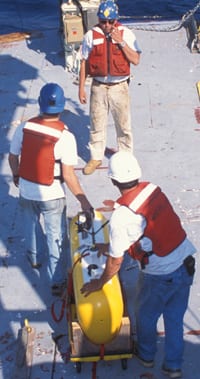New Location of Deep Convection May Exist in North Atlantic
July 16, 2003
Deep convection, or mixing, of ocean waters in the North Atlantic, widely thought to occur in only the Labrador Sea and the Mediterranean, may occur in a third location first proposed nearly 100 years ago by the explorer and oceanographer Fridtjof Nansen. The findings, reported this week in the journal Nature, may alter thinking about the ocean’s overturning circulation that affects earth’s climate.
An international team of scientists reports in Nature that convection, a process that forms deep waters of the world’s oceans and plays a major role in the climate system, may also be occurring in the Irminger Sea east of Greenland because of a sporadic and localized atmospheric phenomenon known as the Greenland tip jet.
Lead author Robert Pickart of the Woods Hole Oceanographic Institution (WHOI) says the study places an additional complexity to the climate puzzle that must now be taken into account in observations and models, and that the implications of an additional source of Labrador Sea Water are far-reaching.
“I believe we found the smoking gun in the debate about deep water formation east of Greenland,” Pickart says. “This study essentially ends a 100-year controversy, and I am convinced we will acquire the data from the ocean profiling system now in place in the Irminger Sea to prove it conclusively in the future.”
The Labrador Sea and the Mediterranean have been thought to be the only locations where open-ocean convection leads to formation of deep water in the North Atlantic to depths of 1500-2000 meters. Polar air blows across Canada during the winter, removing heat over much of the Labrador Sea and causing the surface layers to sink and mix into deep waters. New evidence rekindled interest in Nansen’s idea that a large amount of Labrador Sea Water may actually be formed outside the Labrador Sea in the Irminger Sea.
A recent study by atmospheric scientists focused attention on a phenomenon known as the Greenland tip jet, a narrow, sporadic atmospheric jet that develops off of Cape Farewell when high-level northwesterly winds descend on the eastern or leeward side of Greenland and accelerate as they drop down over the ocean, drawing cold air over the southern Irminger Sea in a relatively small area. Pickart’s team, consisting of WHOI colleague Mike Spall and researchers at the Danish Meteorological Institute, University of Toronto, and Colorado Research Associates Division recognized that this was likely the cause of deep convection in the Irminger Sea. They pulled together corroborating evidence from atmospheric models, meteorological data, remote sensing fields, and oceanic modeling in order to make their case.
Nansen first proposed the idea nearly 100 years ago but much debate and controversy followed in the scientific literature and the notion was never embraced by the oceanographic community. Pickart knew nothing of Nansen’s forgotten theory until a few years ago when he gave a lecture about the “new” idea, and was told by a Norwegian scientist that it had been proposed but discounted decades ago. Intrigued as to why the idea died out, he hired a German translator and reviewed many journal articles for evidence. He is currently working on a popular science book on the demise of Nansen’s hypothesis.
Pickart and colleagues may be able to finally prove the idea with a new ocean profiling system deployed in the Irminger Sea three years ago. Pickart will head to sea in late July to recover and redeploy the instrument for another year, and a five-year deployment is planned by Institution colleagues starting in 2005.
About WHOI
WHOI is a private, independent marine research and engineering, and higher education organization located in Falmouth, MA. Its primary mission is to understand the oceans and their interaction with the Earth as a whole, and to communicate a basic understanding of the ocean’s role in the changing global environment. Established in 1930 on a recommendation from the National Academy of Sciences, the Institution is organized into five departments, interdisciplinary institutes and a marine policy center, and conducts a joint graduate education program with the Massachusetts Institute of Technology.

